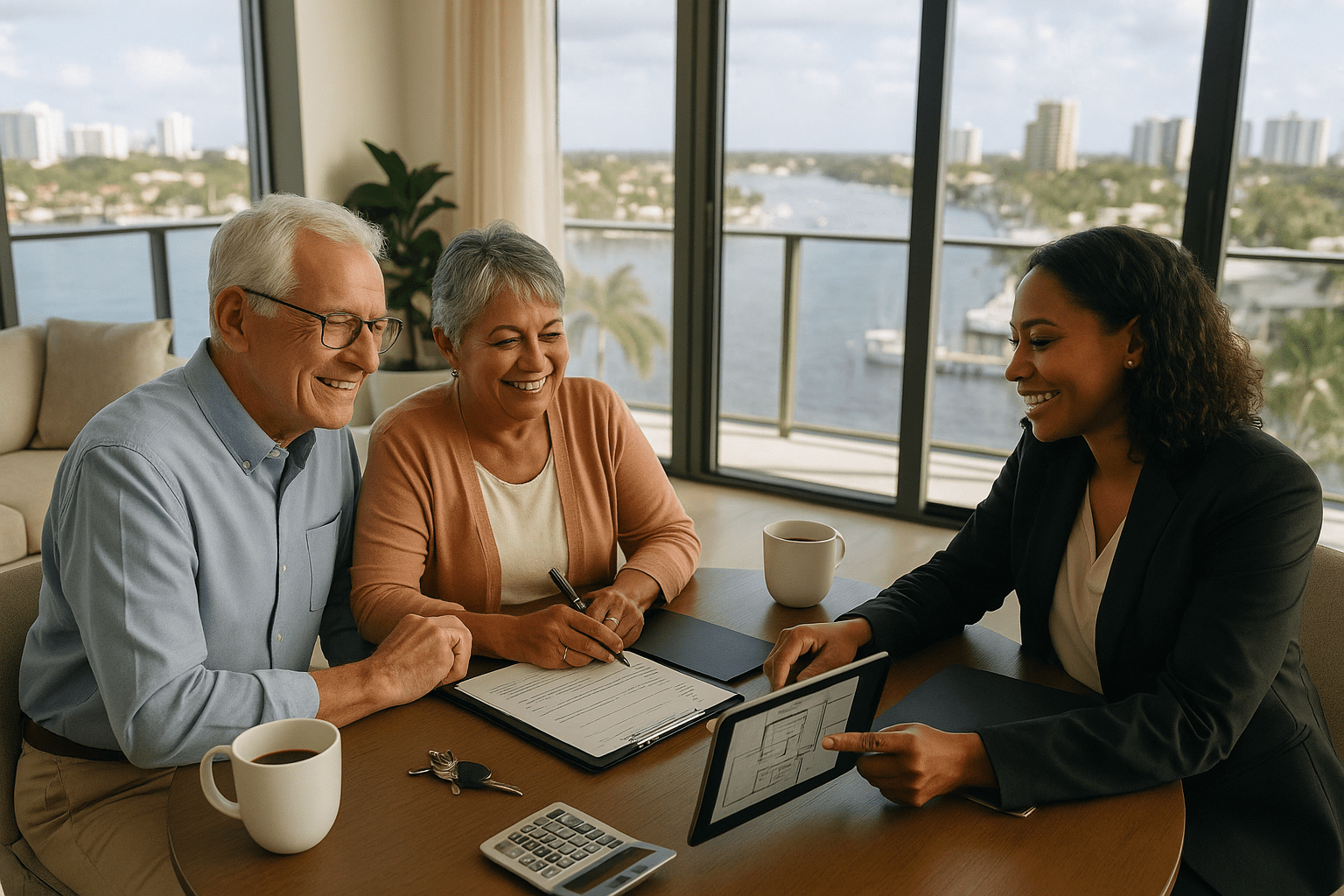Reverse Mortgage: Retired Couple Purchases $685K Dream Home Without Monthly Mortgage Payments Using HECM for Purchase
- By Jim Blackburn
- on
- Buy A House, No Payment, Reverse Mortgage

Educational Case Study Disclosure
This case study is hypothetical and for educational purposes only. Scenarios, borrower profiles, loan terms, interest rates, and APRs are illustrative examples and do not represent current offers or guaranteed terms.
If specific loan terms (e.g., down payment %, payment amount, rate/APR, points, or repayment period) appear in this article, required disclosures will be shown immediately next to those terms per Regulation Z.
For specific details including down payment incentives, closing cost incentives, interest rate details, closing cost breakdowns, payment calculations, cash-to-close estimates, or an official Loan Estimate, it is highly recommended you schedule a meeting with one of our licensed mortgage advisors.
Learn more:
- Reg Z – Advertising (§1026.24) – CFPB official regulation
- Reg Z Full Text – Electronic Code of Federal Regulations
- Official Interpretations to §1026.24 – CFPB interpretations
- MAP Rule (Reg N), 12 CFR Part 1014 – Mortgage advertising rules
- NMLS Consumer Access – Verify licensure
Actual loan terms vary by credit profile, property, occupancy, location, market conditions, and lender guidelines. For current options tailored to you, schedule a consultation or apply online.
Ready to explore your options? Schedule a call with a loan advisor.
How This Reverse Mortgage for Purchase Enabled Downsizing to Luxury Home While Eliminating Monthly Housing Payments in Retirement
Richard and Linda P., a retired couple ages 72 and 69, had successfully built wealth over 45 years through disciplined saving, smart investing, and entrepreneurial success. After selling their manufacturing business three years earlier, they maintained a diversified $2.1 million investment portfolio generating passive income through dividends, interest, and strategic distributions. They owned their family home in Coral Springs (purchased 38 years ago for $145,000, now worth $625,000) with no mortgage—a property that had served them well while raising three children and building careers, but now felt too large, required excessive maintenance, and was located farther from Fort Lauderdale’s cultural amenities and their children/grandchildren than they preferred in retirement.
As senior homeowners (Step 4 in their financial journey), Richard and Linda wanted to downsize to a luxury two-bedroom, two-bathroom condo in Fort Lauderdale’s Las Olas area listed at $685,000—a property offering maintenance-free living, resort-style amenities including pool and fitness center, walkable access to restaurants and cultural attractions, and proximity to their children’s families. The move represented intelligent retirement planning: reducing home maintenance burdens, accessing urban lifestyle, and positioning closer to family while optimizing their financial structure for longevity and legacy.
However, Richard and Linda faced a strategic financial decision about how to structure their new home purchase. They could sell their Coral Springs home (netting approximately $600,000 after selling costs) and purchase the Las Olas condo using traditional approaches—but each option presented significant drawbacks that conflicted with their retirement wealth management goals:
Option 1: All-cash purchase
- Use $685,000 from home sale proceeds
- Pros: No mortgage, no monthly payments
- Cons: Ties up substantial liquid capital in illiquid real estate, reduces investment portfolio generating retirement income, eliminates financial flexibility for emergencies or opportunities, forces liquidation of investments if cash needed
Option 2: Traditional mortgage with monthly payments
- Use portion of proceeds for down payment, finance remainder
- Pros: Preserves some liquidity
- Cons: Creates monthly mortgage payments of $2,500-3,000+ that consume retirement income, requires qualifying income verification, continues housing payment obligations throughout retirement
Option 3: Cash purchase now, reverse mortgage later if needed
- Buy with cash, consider reverse mortgage years later if capital depleted
- Cons: Delays access to equity, may not qualify later due to age/health changes, loses years of potential equity preservation
“We had $600,000 from our home sale, but tying up $685,000 in an all-cash purchase felt financially inefficient,” Richard explained. “That would consume most of our home equity and require liquidating investments—reducing our portfolio from $2.1 million to $1.5 million. We’d lose $50,000+ annually in investment returns from the capital we’d liquidate. And we’d eliminate financial flexibility for emergencies, family support, or opportunities. Traditional mortgages created mandatory $2,500-3,000 monthly payments that would consume $30,000-36,000 annually from our retirement income—money we’d rather preserve for travel, grandchildren, and charitable giving.”
Richard and Linda needed a reverse mortgage for purchase (officially called HECM for Purchase—Home Equity Conversion Mortgage for Purchase)—specialized financing for borrowers 62+ that enables purchasing a new home while eliminating monthly mortgage payments, preserving retirement capital and cash flow while providing lifetime occupancy security as long as property taxes, insurance, and basic maintenance are maintained.
Facing similar retirement home purchase decisions? Schedule a call to explore reverse mortgage for purchase options.
Why Was Reverse Mortgage for Purchase the Optimal Solution?
Richard and Linda researched extensively and discovered that HECM for Purchase (reverse mortgage for purchase) offered strategic advantages over traditional purchase approaches, particularly for retirees seeking to optimize retirement capital deployment and cash flow management.
How reverse mortgage for purchase works:
The borrower contributes approximately 50-60% of purchase price as initial investment (varies based on borrower age and current interest rates), while reverse mortgage financing covers the remaining 40-50%. No monthly mortgage payments are required—interest accrues and is added to loan balance over time. The loan becomes due when the last surviving borrower passes away, permanently moves to assisted living, or sells the property. At that time, borrowers or heirs repay the loan (typically through home sale) or can keep the property by paying off the balance.
Richard and Linda’s reverse mortgage for purchase structure:
- Purchase price: $685,000
- Required initial investment: Approximately $355,000 (52% based on their ages 72/69)
- Reverse mortgage financing: Approximately $330,000 (48%)
- Monthly mortgage payment: $0 (no required payments)
- Home sale proceeds available: $600,000 from Coral Springs sale
- Remaining capital preserved: $245,000 stays invested in portfolio
Strategic advantages over alternatives:
Versus all-cash purchase ($685,000):
- Preserves $330,000 in investment portfolio (remains invested, earning returns)
- Maintains $330,000 in financial flexibility for emergencies, family support, opportunities
- No monthly mortgage payments (same as cash purchase)
- Lifetime occupancy guaranteed (same as ownership)
- Investment returns on preserved $330,000 substantially exceed reverse mortgage interest accrual cost
Versus traditional mortgage (20% down, conventional financing):
- Eliminates $2,500-3,000 monthly mortgage payments ($30,000-36,000 annually)
- Preserves $180,000+ additional retirement income over retirement (no payments for likely 15-20+ years)
- No income qualification required (no scrutiny of retirement income sources)
- No risk of payment default or foreclosure from income reduction
- Guaranteed lifetime occupancy regardless of financial circumstances
Financial analysis of reverse mortgage for purchase:
Richard and Linda’s financial advisor performed comprehensive analysis comparing the three purchase approaches over a 20-year retirement projection:
All-cash purchase:
- Initial capital required: $685,000
- Investment portfolio remaining: $1,500,000 (after liquidating $600K for cash purchase)
- Annual portfolio returns lost: $50,000+ (on $600K that would remain invested with reverse mortgage)
- 20-year opportunity cost: $1,000,000+ in lost investment returns and compounding
Traditional mortgage:
- Monthly payments: $2,800 (estimated on $550,000 mortgage after $135,000 down)
- Annual payment cost: $33,600
- 20-year total payments: $672,000
- Plus interest: Approximately $430,000 over term
- Total 20-year cost: $1,100,000+ in payments and interest
Reverse mortgage for purchase:
- Initial investment: $355,000 (from home sale proceeds)
- Capital preserved: $245,000 (remains invested earning returns)
- Monthly payments: $0
- Interest accrual: Approximately $8,000-10,000 annually on $330,000 balance
- 20-year total interest accrual: $160,000-200,000 (varies with rates and compounding)
- Investment returns on preserved $245,000: $490,000+ over 20 years (at 8% annual return)
- Net 20-year benefit: $290,000-330,000 (returns minus interest accrual)
“The financial analysis was compelling,” Linda said. “The reverse mortgage for purchase let us use $355,000 from our home sale to purchase the $685,000 condo—preserving $245,000 that stays invested earning returns. We have zero monthly mortgage payments, so we preserve $33,600 annually that would go to traditional mortgage payments. Our investment returns on the preserved $245,000 substantially exceed the reverse mortgage interest that accrues. Over 20 years, we’d come out approximately $300,000 ahead compared to traditional financing, while enjoying the same luxury condo with no payment stress.”
Richard and Linda also valued non-financial benefits:
- Payment elimination: No monthly mortgage obligation consuming retirement income
- Cash flow preservation: Full retirement income available for living expenses, travel, family support
- Financial flexibility: $245,000 preserved for emergencies, family needs, opportunities
- Longevity protection: If they live to 90s, no risk of outliving ability to make mortgage payments
- Portfolio optimization: Maximum capital remains invested in diversified assets earning returns
- Legacy enhancement: Preserved capital can pass to heirs or fund charitable giving
- Stress reduction: No payment default risk regardless of income fluctuations or portfolio performance
Experiencing similar retirement purchase decisions? Schedule a call to discuss reverse mortgage for purchase.
How Did Richard and Linda Discover Reverse Mortgage for Purchase?
During initial discussions with their financial advisor about the Las Olas condo purchase, Richard and Linda assumed they’d either buy with cash or take a traditional mortgage. The advisor immediately suggested considering reverse mortgage for purchase (HECM for Purchase) as a potentially superior strategy that most retirees don’t know exists.
“Our financial advisor said, ‘Before you commit to all-cash or traditional mortgage, let’s analyze reverse mortgage for purchase—it might optimize your retirement capital deployment,'” Richard explained. “We’d heard of reverse mortgages for accessing equity from homes you already own, but didn’t know you could use a reverse mortgage to purchase a new home. The advisor had helped several retired clients use HECM for Purchase to downsize or relocate while eliminating monthly payments and preserving retirement capital.”
The financial advisor explained that HECM for Purchase was created specifically for retirees purchasing new homes—whether downsizing, relocating to be near family, moving to retirement communities, or relocating for climate/lifestyle preferences. The program recognizes that retirees often have substantial home equity from their current property but want to optimize capital deployment in their new home rather than tying up all proceeds in all-cash purchases or creating monthly payment obligations through traditional mortgages.
“The concept made immediate sense once explained,” Linda added. “We’d use approximately half our home sale proceeds as the initial investment on our new condo, while reverse mortgage financing covered the other half. We’d have zero monthly mortgage payments—just like an all-cash purchase—but we’d preserve $245,000 that stays invested in our portfolio earning returns. That preserved capital provides financial flexibility while generating investment income that far exceeds the reverse mortgage interest accrual. It’s intelligent leverage for retirement—using the bank’s capital at low cost while keeping more of our own capital working for us.”
The advisor referred them to a reverse mortgage specialist who explained program details, requirements, and process. The loan officer emphasized that HECM for Purchase requires mandatory HUD-approved counseling to ensure borrowers fully understand the program—a consumer protection that Richard and Linda appreciated as evidence of program legitimacy and appropriate oversight.
What Documentation Was Required for This Reverse Mortgage Purchase?
Richard and Linda worked with their reverse mortgage specialist to complete the HECM for Purchase application process, which includes unique requirements for this specialized financing.
Documentation provided:
- Ages verified: 72 and 69 (both borrowers 62+, required for reverse mortgage eligibility)
- Government-issued photo IDs (driver’s licenses)
- Social Security cards
- Proof of U.S. citizenship or permanent residency
- Current home sale documentation (listing agreement, accepted offer, estimated proceeds)
- Bank statements showing funds for required initial investment ($355,000)
- Credit report (reverse mortgages don’t require specific credit scores, but financial assessment reviews credit history)
- Income documentation for financial assessment (tax returns, bank statements, Social Security award letters)
- Property tax and homeowners insurance payment history (demonstrates ability to maintain obligations)
- Purchase contract for Las Olas condo at $685,000
- Homeowners insurance quote for new property
- HOA documents and condo questionnaire
- Property appraisal (ordered during process)
- HUD-approved reverse mortgage counseling certificate (REQUIRED)
The HUD counseling requirement:
Before applying for any reverse mortgage, borrowers must complete HUD-approved counseling with an independent certified counselor. This typically one-hour session (phone, video, or in-person) covers:
- How reverse mortgages work
- Costs and fees
- Alternatives to consider
- Borrower responsibilities (taxes, insurance, maintenance)
- Repayment triggers and process
- Impact on heirs and estate planning
“The mandatory HUD counseling was valuable,” Richard said. “The independent counselor explained everything clearly without sales pressure—how the reverse mortgage works, what our responsibilities are, when the loan becomes due, how it affects our estate. We appreciated this consumer protection ensuring we fully understood the commitment. The counselor confirmed reverse mortgage for purchase made sense for our situation given our ages, financial position, and goals.”
The approval process:
- Initial consultation (Day 1) – Discussed reverse mortgage for purchase strategy
- HUD counseling scheduled (Day 3) – Enrolled in required independent counseling
- HUD counseling completed (Day 10) – One-hour session, received certificate
- Application submission (Day 12) – Submitted complete HECM for Purchase application
- Financial assessment (Days 13-18) – Lender reviewed ability to maintain taxes, insurance, maintenance
- Credit review (Days 19-20) – Evaluated payment history and financial responsibility
- Fund verification (Days 21-22) – Confirmed ability to provide required $355,000 initial investment
- Purchase contract review (Day 23) – Verified property details and purchase price
- Property appraisal ordered (Day 24) – Las Olas condo appraisal scheduled
- Appraisal completed (Day 31) – Condo appraised at purchase price
- Underwriting review (Days 32-42) – Comprehensive reverse mortgage analysis
- Conditional approval (Day 43) – Approved pending minor documentation
- Final approval (Day 48) – Clear to close
- Reverse mortgage counseling verification (Day 49) – HUD certificate confirmed valid
- Closing coordination (Day 50) – Synchronized with home sale closing
- Closing (Day 55) – Funded reverse mortgage for purchase, closed on Las Olas condo
The lender approved Richard and Linda’s reverse mortgage for purchase based on their ages 72/69 (both well above 62 minimum), financial assessment showing ability to maintain property taxes, insurance, and basic maintenance from retirement income, sufficient funds verified for required $355,000 initial investment from home sale proceeds, excellent payment history on current property taxes and insurance, property appraisal confirming value and FHA eligibility, completion of mandatory HUD counseling requirement, and overall financial profile demonstrating responsible homeownership capacity.
“The approval process was thorough but reasonable,” Linda explained. “The financial assessment verified we have sufficient retirement income to maintain property taxes, insurance, and basic upkeep—which we absolutely can from our $2.1 million portfolio. They confirmed we had the $355,000 initial investment from our home sale. They verified we’d completed HUD counseling and understood the program. The entire process took about 55 days and closed simultaneously with our home sale—perfect coordination.”
Ready to purchase using reverse mortgage? Submit a reverse mortgage inquiry to discuss options.
What Were the Final Results of This Reverse Mortgage Purchase?
Richard and Linda successfully closed on their Las Olas condo using reverse mortgage for purchase financing, achieving their downsizing goals while optimizing retirement capital deployment and eliminating monthly mortgage payments.
Final reverse mortgage for purchase details:
- Purchase price: $685,000
- Required initial investment: $355,000 (52% of purchase price, based on ages 72/69)
- Reverse mortgage amount: $330,000 (48% of purchase price)
- Monthly mortgage payment: $0 (no required payments—interest accrues and adds to balance)
- Coral Springs home sale proceeds: $600,000
- Capital preserved in portfolio: $245,000 (remained invested after $355K initial investment)
- Competitive reverse mortgage rates –Reverse Mortgage Calculator to explore scenarios
- Property type: 2BR/2BA luxury condo, Las Olas, Fort Lauderdale, FL
- Amenities: Pool, fitness center, concierge, parking, walkable urban location
Strategic financial outcome:
- Payment elimination achieved: $0 monthly mortgage payment versus $2,800 with traditional financing
- Annual cash flow preserved: $33,600 (no mortgage payments consuming retirement income)
- Investment capital preserved: $245,000 remained invested in diversified portfolio
- Annual investment returns maintained: $19,600+ on preserved capital (at 8% return)
- Net annual benefit: $13,000+ (investment returns minus reverse mortgage interest accrual)
- 20-year projected benefit: $290,000-330,000 versus traditional mortgage
- Financial flexibility maintained: $245,000 available for emergencies, family support, opportunities
- Retirement income maximized: Full portfolio distributions available for living expenses and discretionary spending
Richard and Linda moved into their Las Olas condo within weeks of closing, immediately enjoying the maintenance-free lifestyle, resort-style amenities, and urban location they’d envisioned. The two-bedroom layout provided perfect space for their needs while offering a guest room for visiting children and grandchildren. The walkable location meant restaurants, cultural attractions, and waterfront parks were accessible by foot or short drive. The building’s concierge service and amenities eliminated home maintenance burdens they’d managed for 38 years.
“The reverse mortgage for purchase transformed our retirement lifestyle and financial security,” Richard explained. “We’re in our dream condo in the perfect location with zero monthly mortgage payments. We preserved $245,000 in our investment portfolio that continues earning returns—generating approximately $20,000 annually that far exceeds the $8,000-10,000 in annual reverse mortgage interest accrual. We’re coming out ahead financially while enjoying maintenance-free luxury living near our family. Our monthly cash flow is $2,800 better than if we’d taken a traditional mortgage—that’s $33,600 annually we can spend on travel, supporting grandchildren’s education, charitable giving, and enjoying retirement rather than making mortgage payments.”
The reverse mortgage for purchase also provided non-financial benefits that enhanced their retirement security and peace of mind:
- Longevity protection: If they live into their 90s (entirely possible with improving life expectancy), they never worry about outliving ability to make mortgage payments or being forced to sell due to payment difficulties
- Income flexibility: If investment returns decline temporarily or if they need to reduce portfolio distributions for any reason, they have no mortgage payment obligation affecting housing security
- Family proximity: The Las Olas location puts them 15 minutes from their daughter’s family versus 45 minutes from Coral Springs—enabling more frequent grandparent time and family support
- Lifestyle enhancement: Urban walkability, cultural amenities, and social opportunities enriched their daily living far beyond what their Coral Springs location offered
- Legacy preservation: The $245,000 preserved in their portfolio can fund charitable giving or pass to children/grandchildren rather than being locked in illiquid real estate
“The best part is understanding we made optimal financial and lifestyle decisions,” Linda added. “We’re in a better home in a better location with better lifestyle—while simultaneously improving our financial position. The $245,000 we preserved keeps earning investment returns that exceed the reverse mortgage interest cost. We have zero payment stress—no monthly obligation consuming our retirement income. We maintained maximum financial flexibility for whatever life brings. And when we eventually pass or need to move to assisted living, our children will either sell the condo and pay off the reverse mortgage (keeping any remaining equity) or keep the property by paying off the balance. Either way, we optimized our retirement years while preserving maximum wealth for our legacy.”
When Richard and Linda need additional strategies for retirement income optimization, they may explore reverse mortgage line of credit or other wealth management tools for seniors.
Ready to purchase with reverse mortgage? Get approved or schedule a call to discuss HECM for Purchase.
What Can Retirees Learn from This Reverse Mortgage Purchase Success?
- Reverse mortgage for purchase (HECM for Purchase) enables buying new homes while eliminating monthly payments—Richard and Linda purchased $685K condo with zero mortgage payment requirement (HUD HECM for Purchase information)
- Typical initial investment required is 50-60% of purchase price (varies by age)—older borrowers may qualify for lower initial investments
- Preserving retirement capital in investments often generates returns exceeding reverse mortgage interest accrual—$245K preserved earned $20K annually versus $8-10K annual interest cost
- Payment elimination preserves $30,000-40,000+ annually in retirement cash flow—money available for living expenses, travel, family support instead of mortgage payments
- Mandatory HUD counseling ensures borrowers understand program and responsibilities—consumer protection providing education and alternatives analysis
- Both borrowers must be 62+ for reverse mortgage eligibility—program specifically designed for senior homeowners
Have questions about reverse mortgage for purchase? Schedule a call with a loan advisor today.
Alternative Loan Programs for Senior Home Purchases
If a reverse mortgage for purchase isn’t the perfect fit for your situation, consider these alternative financing options:
- Conventional Loan – Traditional financing with monthly payments if you prefer payment structure or are under 62
- Jumbo Loan – For luxury properties exceeding conforming loan limits
- Bank Statement Loan – For retirees with complex income not easily documented
- Asset-Based Loan – Qualification based on investment portfolio rather than income
- No-Doc Loan – For high-net-worth buyers with substantial assets
- Reverse Mortgage Refinance – To eliminate payments on current home (if staying put rather than purchasing new)
Explore all loan programs to find your best option.
Want to assess your retirement home purchase strategy? Take our discovery quiz to clarify your goals.
Helpful Reverse Mortgage for Purchase Resources
Learn more about this loan program:
- Complete Reverse Mortgage Guide – HECM for Purchase requirements and benefits
- Reverse Mortgage Calculator – Estimate initial investment required based on age
Similar success stories:
- Reverse mortgage refinance to eliminate payments – Converting traditional mortgage to payment-free structure
- Reverse mortgage for retirement income – Using line of credit for cash flow
- Browse all case studies by journey stage
External authoritative resources:
- HUD HECM for Purchase Program – Official government information
- AARP Reverse Mortgage Resources – Independent consumer education
- CFPB Reverse Mortgage Guide – Consumer Financial Protection Bureau guidance
- National Reverse Mortgage Lenders Association – Industry standards and education
Ready to take action?
- Submit reverse mortgage inquiry – Discuss purchase strategy
- Schedule consultation – Explore reverse mortgage for purchase
- Take discovery quiz – Clarify retirement and legacy goals
Need local expertise? Get introduced to partners including senior housing specialists and retirement financial advisors.
Need a Pre-Approval Letter—Fast?
Buying a home soon? Complete our short form and we’ll connect you with the best loan options for your target property and financial situation—fast.
- Only 2 minutes to complete
- Quick turnaround on pre-approval
- No credit score impact
Got a Few Questions First?
Not Sure About Your Next Step?
Skip the guesswork. Take our quick Discovery Quiz to uncover your top financial priorities, so we can guide you toward the wealth-building strategies that fit your life.
- Takes just 5 minutes
- Tailored results based on your answers
- No credit check required




